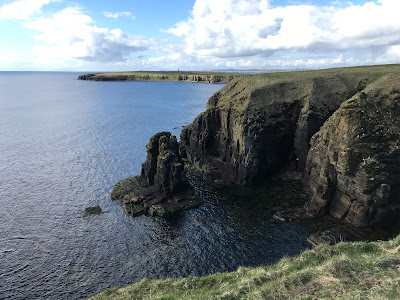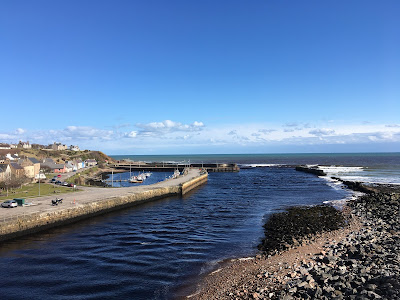Readers of this blog will be aware of my passion for all
wildlife or, to be more correct, nearly all wildlife. Plants, birds, insects,
mammals, fungi and the occasional lichen all grace these pages without fear or favour.
Their life cycles and day-to-day goings on are an endless source of interest to me which I am only too happy to document in my haphazard and meandering way.
However, I have often felt a bit of a fraud due to my reluctance to engage with
anything remotely spidery, and believe me, the remoter the spider the better, to
my mind. I know that I am not alone in this regard, but there’s still a lingering
guilt that I’m letting the side down in some way. Yup, my middle name is not Jain.
My conscience has been salved a little over the years whenever
I have read of a similar feeling being shared by others, including several
well-known, and respected, natural history authors. I might not be able to bang
out a book like Simon Barnes or David Quammen, but I might harbour the
heretical thought that I am tempted to bang down a book just like they do, when
faced with eight legs and eight eyes in close formation. I’m not talking Abba or The Beatles here, but to strain the analogy, perhaps The Who, if they’re singing ‘Boris the Spider’.
In his book, ‘Ten Million Aliens’, Simon Barnes tells the
tale of being dropped off at his guest lodgings, a hut in a Zambian reserve, slightly the worse for alcoholic beverages. Once crashed out on the bed, he became aware of the 47 (shudders) wolf
spiders foraging over the walls and ceiling, most of them with a 6 inch leg
span, and for a fleeting instant, he considered walking the mile back to his
host’s accommodation, through the pitch black night and lion territory. What a choice
to have to make?
My all time favourite book 'The Song Of The Dodo' by David Quammen features several incidents of an arachnoid nature, each described with scientific accuracy and emotional honesty. However, in his article ‘The Face Of A Spider – Eyeball to Eyeball
with the Good, the Bad, and the Ugly’, published in 'The Flight Of The Iguana', David Quammen admits to his dilemma when
faced with a hundred baby Black Widow spiderlings crawling all over his writing
desk and office, and the life-changing decision he made that evening. Very
life-changing for the spiderlings, and very thought-provoking for the author.
Looking back at the instances of my arachnophobia within
Imperfect & Tense, there have not been quite the same levels of life or
death moments, and I certainly do not seek out intimate encounters on the web,
or yearn for the touch of silk.
Occasionally, in the course of my work, I will find myself
in a cramped corner of a dusty loft, concentrating on keeping my balance,
whilst juggling a torch and several cable-terminating tools. If I’m lucky, I
may catch a glimpse of a soundless movement, between the harsh glare from the
bulb and the deep shadows cast by the roof trusses. Well, I say lucky, but only
because there’s a few microseconds of warning before the flight reflex kicks
in, and as opposed to suddenly finding myself cheek by jowl with a creature
that can certainly keep more than one eye on me.
So, you will be forgiven for being as incredulous as I was, this week, when I had the arachnid equivalent of the moment experienced by St Paul,
although I was on the internet, rather than the road to Damascus.
A natural history colleague, with a knack of finding
‘new-for-Orkney’ invertebrate species, not to mention proper 'spidey skills',
had posted a comment on the social media page of a wildlife group. The comment mentioned the fact that there weren’t any records for zebra spiders in this neck of the
woods. On reading those few, simple words, I was transported back in time to every house I
had ever lived in before moving to Orkney. Although they were spread across decades and several countries, these homes shared one very definitive
experience: zebra spiders in the cloakroom. You read that correctly, spiders in the smallest room in the house. What you might, indeed, describe as a call of Nature. And I was suddenly and unexpectedly very sad, a feeling that hadn't previously troubled that bit of my psyche where spiders were concerned.
You see, there’s something lovable,
and I don’t think that’s too strong a word for it, yup, lovable, about a zebra
spider. Yes, they’re possessed of the expected eight legs and eyes; yes,
they’re likely to move at a speed and in a direction that is unpredictable and,
appropriately, gut-wrenching; but for a spider, they are undeniably… look, I
can’t help myself here, they are just cute. And, as if you need reminding, this
is when you’re sat half naked and likely fully nervous, with your mind on other
things. But in zebra spider terms, it’s the best seat in the house.
It was a curious moment, realising that I missed their
stripey presence in my life. So I took to the internet to acknowledge the fact,
to reconsider my troubled relationship with the arachnid order and to ponder the thought that a journey begins with the first eight steps.















































